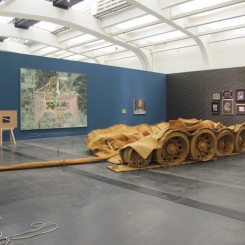“ON | OFF: China’s Young Artists in Concept and Practice”
Ullens Center for Contemporary Art (798 Art District, No. 4 Jiuxianqiao Lu Chaoyang District, Beijing) Jan 13 – Apr 14, 2013
In my experience, Ullens rarely opens up the entirety of its vast space for any one exhibition. But this year, Ullens has mobilized its forces to make the “ON|OFF” show one of the rare recipients of this accolade. According to the curators, “ON | OFF” is a type of VPN software (See “Flipping the Switch with Sun Dongdong”). Thus, this title is meant to evoke a hint of the political. It ultimately becomes ambiguous and incomprehensible, however, because everything has its opposing force: positive versus negative, on versus off, the solitary versus the group, motion versus stillness. In addition, the speculative implications of this title are drowned in the “jubilant” atmosphere of the exhibition itself. Fifty young artists take part in this show, and most of their works are either displayed in an atypical fashion, or are works of non-traditional media: installations, interactive participation, video works et cetera. In the current creative atmosphere of the mainland, where contemporary art continues to revert inexorably back toward the conservative, such a provocative exhibition is hard to come by, even if the greater significance for Ullens may simply be a grand gesture.
The first work we see upon entering Ullens is a huge inflatable mechanical bull. The air pump works away, accompanied by the jaunty strains of the Paso Doble. With the participation of its audience, this bull becomes by turns “riled up” or “downcast” (Xin Yunpeng’s “No Problem”, 2013). From the hall opposite this piece comes an even more earth-shattering noise. Almost the entire hallway is taken over by Tang Dixin’s large-scale installation “Reverse” (2012). It features what appear to be wind-powered vehicles with pedals. Behind each of these vehicles, the artist has installed a propeller formed of turning gears which set the cars into motion. A giant industrial fan has been placed behind these smaller vehicles, and the turning of its massive fan blades is what emits the aforementioned sound. Although the scale and visual impact of the installation comes as a surprise, its concept falls back on the power of industrialization versus the forces of nature. Of course, viewers may glean individual significance from the piece. The last large-scale work found in “ON|OFF” is He Xiangyu’s “Tank Project” (2011-2013). A life-sized tank droops in the center of the exhibition space, where the artist has placed his work: its entire form made out of a wholly unexpected material – leather. Whether the artist is referencing the not-so-distant past or the current hypersensitive period of border disputes, this work and its militaristic implications comes off as all the more relevant.

Xin Yunpeng, ”No Problem,” PVC inflatable model, silica gel, pneumatic equipment, 500 × 500 cm, 2013.
This so-called “consciousness-raising” seems to be the driving force behind most of the artists’ pieces. An example is found in Li Liao’s “Consumption” (2012), where the artist calls out sweatshops such as Foxconn through the incorporation of readymade objects like Apple products and name tags in his work. Zhao Zhao’s “Repetition” (2012) is a three dimensional sculpture reconstructed from fragments of ancient Buddha sculptures. Symbolism makes the work a challenge to history and a thought piece on faith. Xu Qu’s piece “It’s Not a Matter of Time” (2012-2013) attempts to stimulate the audience’s reflection on consumption, repetitive labor and value by constantly refilling cups of coffee and jugs of purified water. Many artists did not significantly modify the style or mode of their pieces to differ from their previous works (some pieces were even provided by organizations they previously exhibited with). Li Ran’s dubbed music video “Born Again”, Liang Yuanwei’s heavily textural duo of paintings “Pisces” (2012), and Wang Guangle’s “121101” (2012) are just a few examples.
Truth be told, there is no clear theme to be found at this exhibition. To put it more simply, it is a group exhibition of chosen artists. Thus, the unifying framework of the exhibition naturally forms around “young artists”. But the subject of “youth” has become over-used and exhausted in the contemporary art scene. In recent years, we’ve seen a long line of these shows. Shows featuring young artists have appeared, one after the other, following last year’s “First CAFAM Exhibition of the Future: Subculture – A Report on the State of Young Chinese Artists” the Central Academy of Fine Arts Museum and “Daily Concept: A Practice of Life” held by Shanghai Duolun Museum of Modern Art. What’s more, the names on the lists of artists participating in these exhibitions seem to be repeated to such an extent that “young artists” has become a defined group of individuals. What should be noted is that this group has been formed selectively. Taking the current exhibition as an example, the range of birth dates for the artists fall between 1976 and 1989. If viewed from a biological standpoint, it’s hard to call many of these artists “youths”, because the age range includes the post-70s generation and the post-80s generation. Interestingly enough, these artists born just a single decade apart represent two generations entailing the most diametrically opposed value-systems and environments witnessed since the formation of “New China” (post-Cultural Revolution). In other words, so-called “youth” in contemporary art or in a broader context is more of a declaration of values. The word represents – or rather, is thought to represent – the qualities of reflection, sensitivity, analysis, ego, subversion, and creativity.


